Harpejji M5 Review - Part 1: Outer Aspects
Context
I was lucky enough to discover the harpejji relatively early after it was commercialized - my beloved K24 has serial number #00063. I’ve been playing it for more than 10 years, documenting my progress and sharing tips through various posts on this site. Along the way, I also proposed a tab notation to share fingerings in the harpejji community and contributed to develop the tab editor that Marcodi later included on their website.
The “full-range” aspect of the instrument has always appealed to me, so when the g16 and the u12 came out, I wasn’t really interested, although they did include some technical innovations that I was curious about.
But of course when Marcodi announced the new M5 series that was completely different! A new full-range instrument (5 octaves) with improvements brought by almost 15 years of experience building harpejjis? I must admit I was extremely curious.
After some hesitations, I decided to take the jump and I ordered a M5. It seems that I’m relatively early again as I received an instrument with serial number #00018!
This post is the first in a series that should constitute a full in-depth review of the new instrument, with detailed comparison to the earlier K24.
Full disclosure Marcodi was kind enough to offer me a discount on the instrument so that I could write this review. I did accept the discount, but apart from that I’m not affiliated in any way to Marcodi. The things I write in this series of posts are purely my opinions, expressed completely freely!
Unpacking the M5
As far as I can remember, unpacking a harpejji in 2013 was just that: unpacking a harpejji (with cable and power supply). In 2025, I also got a “quick start guide”, a set of tools for tuning and tweaking the harpejji, a couple of string cleaning wipes and a nice, handwritten note from Joy Meeks.
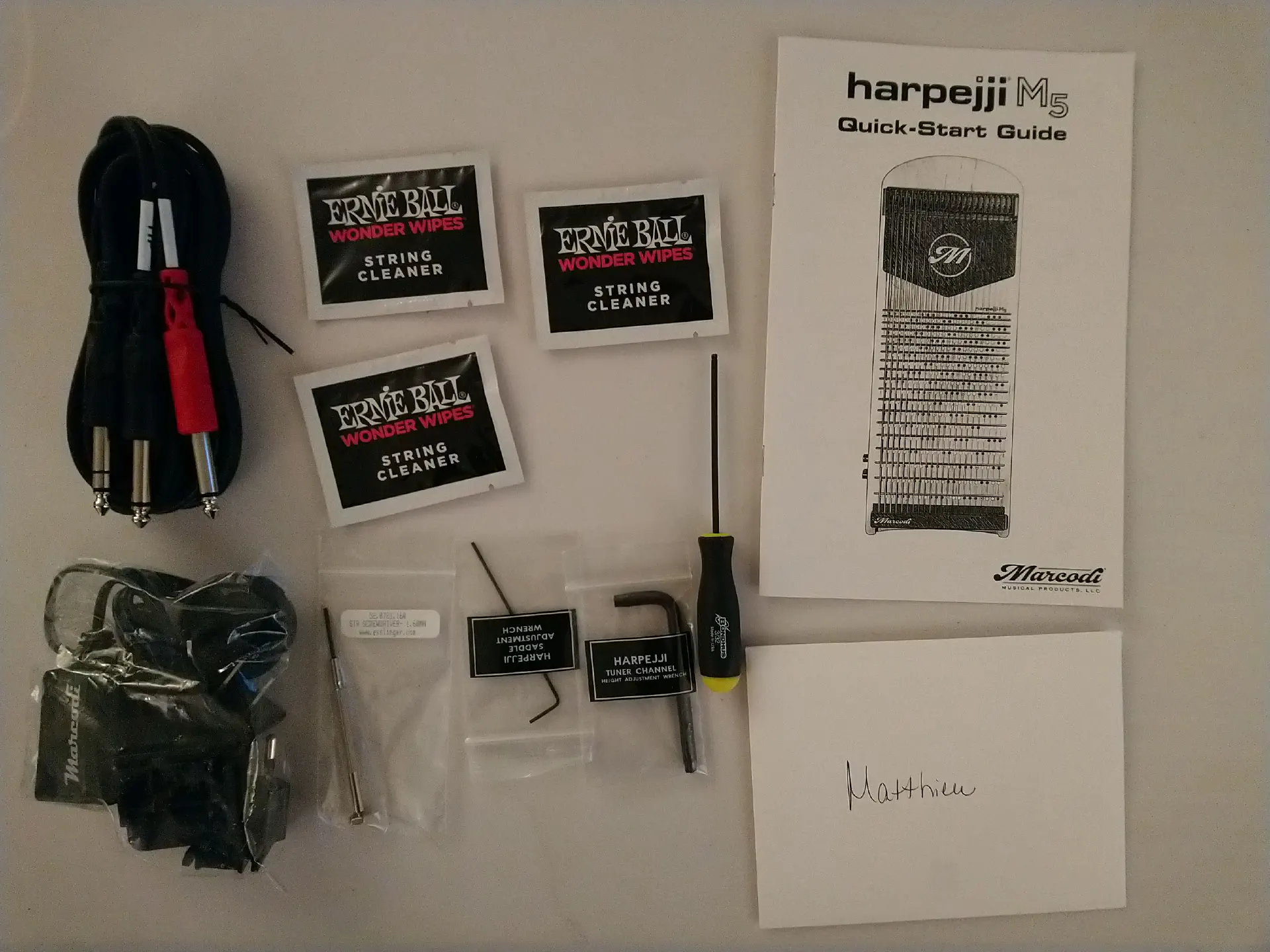
The “quick start guide” includes basic information about harpejji parts and accessories, setup, tuning and string gauges. It also contains a QR code linking to a youtube playlist of harpejji How To videos. This is a good idea, although I feel the playlist could be updated and refreshed a little bit
I think the addition of these items really enhances the unpacking experience. Someone getting her first harpejji will probably feel a little bit less lost than 10+ years ago.
I got my instrument with a Gator gig bag. Although it feels a little bit less sturdy and definitely less comfortable than the Mono case I bought for my K24, I think it’s definitely up to the task - and much cheaper!
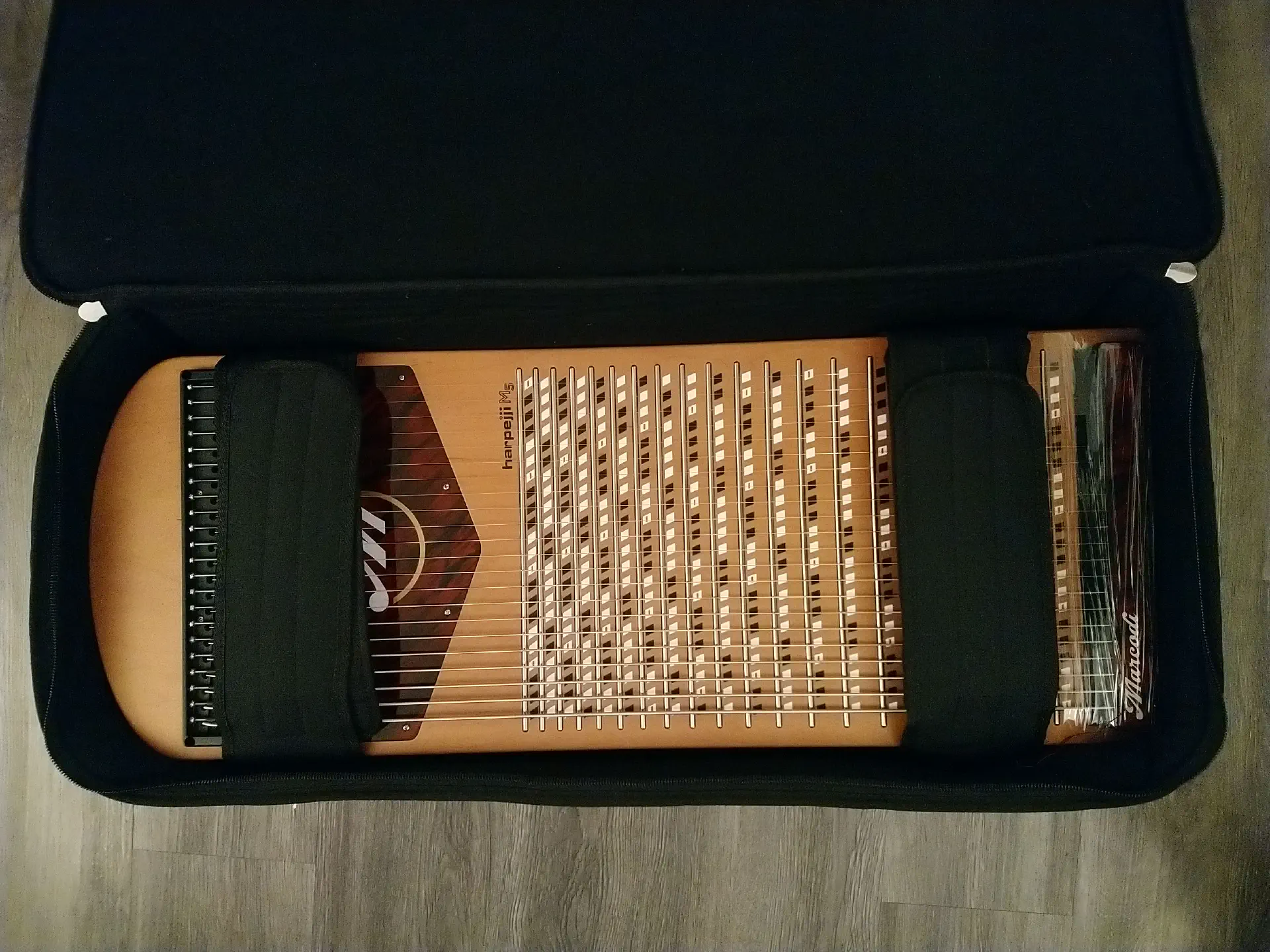
The harpejji M5, physical aspects
Dimensions
The M5 is slightly shorter and, oddly enough given the 2 strings less, slightly wider than the K24. But of course the string spacing is exactly the same and I don’t think the physical dimensions would make any big difference in any real situation (except that the M5 does of course not fit into the custom K24 flight case, which is discontinued anyway).
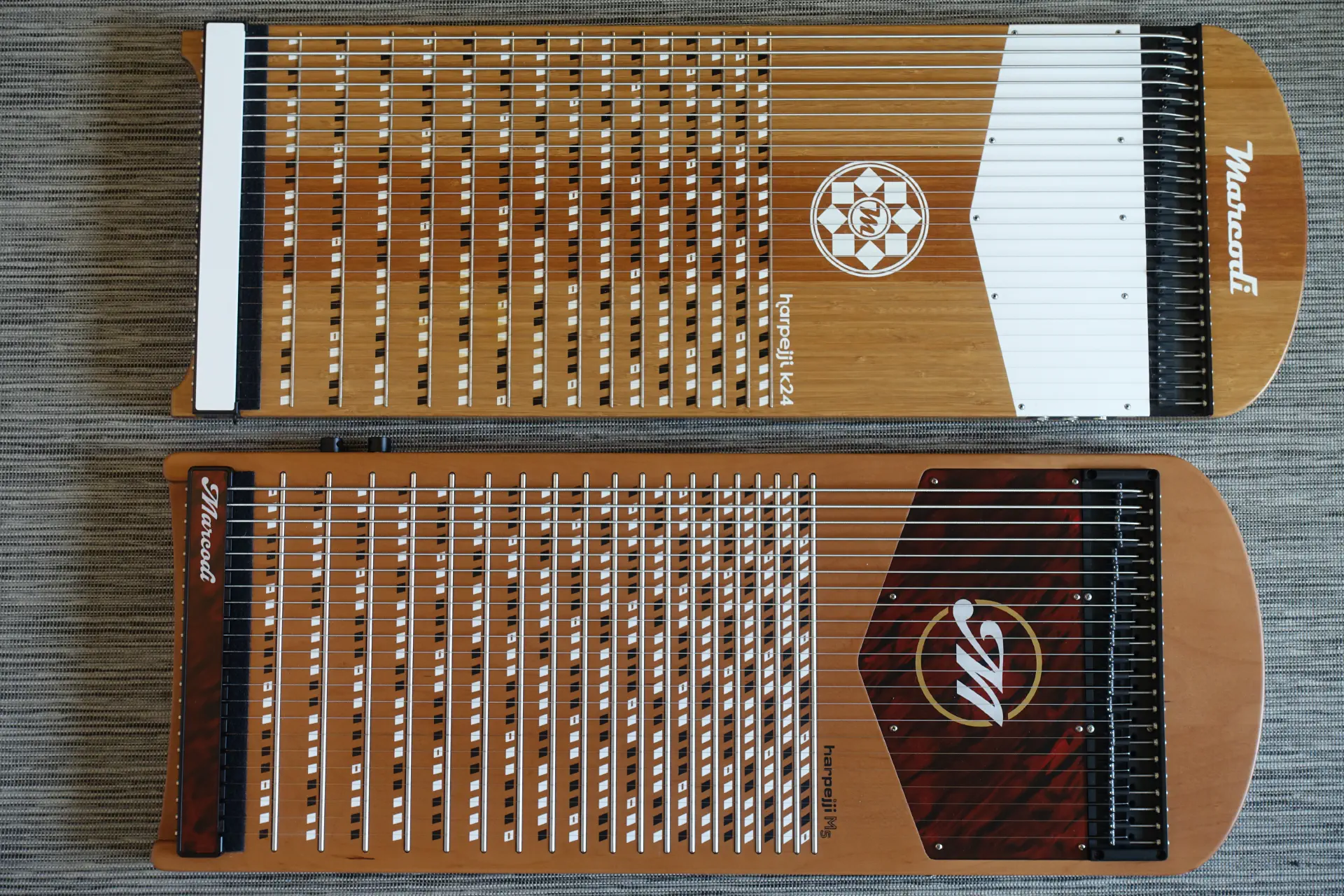
Wood
I selected the 13-ply maple model for my M5. When I ordered it, it was the middle model between the cheaper birch and the “premium” bamboo models. When writing this post, I see that the bamboo model is not available and the maple one is the “premium” model. I don’t know if this is just now or if they gave up producing the bamboo M5’s.
My K24 is out of bamboo. Funnily enough, when I ordered it, bamboo was the budget option, and maple was considered as an upgrade. Not sure what made Marcodi invert their value scale.
Anyway, that means that when comparing the two models, I will be comparing woods as well electronics and frets and whatnot. I’ll have to keep this in mind!
Note Markers
Maybe it’s out of habit, but I prefer the historic “rhombus” note markers rather than the newer “circle” ones (and I truly dislike “ABC” markers, so that was never an option). Hence rhombus is what I chose for my M5. Note that the markers on the new instrument are a few millimeters apart from the frets, unlike the older K24 where the markers were right behind the frets. I think the new design might lure beginners into hitting the strings a little bit too far from the frets, so I’m not sure this was a good design decision. But at least for an experimented player, the difference is very small and quickly gets forgotten.
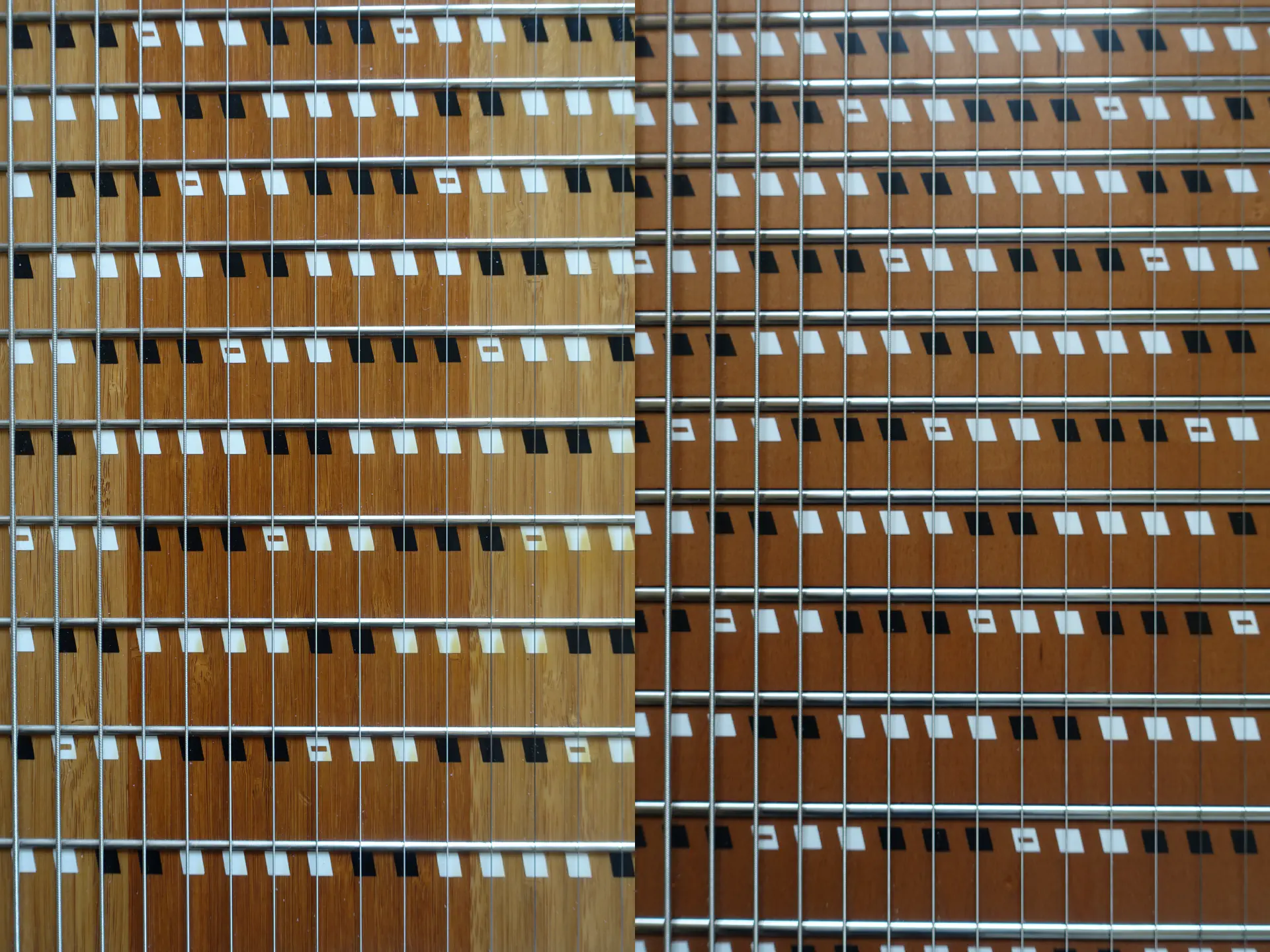
Tuning Wrench
The K24 has a slot for keeping a small tuning wrench inserted into the instrument. I do like this setup, as the wrench is always there when you need it. For some reason Marcodi did not include this feature in the new M5, which come with a bigger, more comfortable but separate wrench. That’s a point where I prefer the older model, but of course that’s a tiny detail.
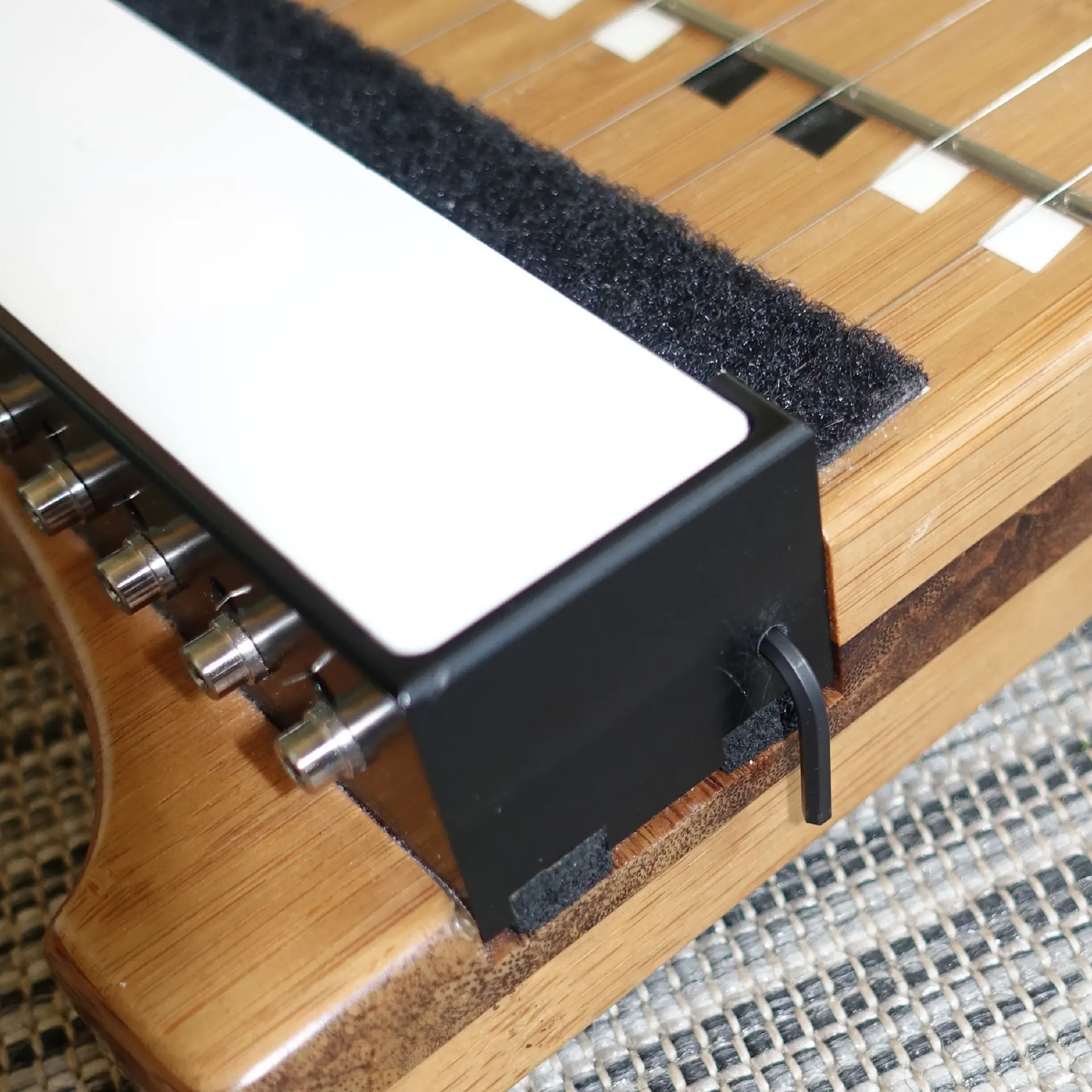
Knobs placement and shape
Now that’s a point where the new M5 clearly is an improvement. On the K24, the tone and volume knobs are on the player side of the instrument, and it happened more than once that I would bump the knobs - especially the volume one - and modify the settings while playing. Also, the knobs where round with no marker, so reproducing a given setup was rather difficult.
On the M5, the knobs are on the left side of the instrument, so accidental bumping by the player is impossible. Also, the new drop shape of the buttons make it much easier to quickly get to a given setting without guesswork.
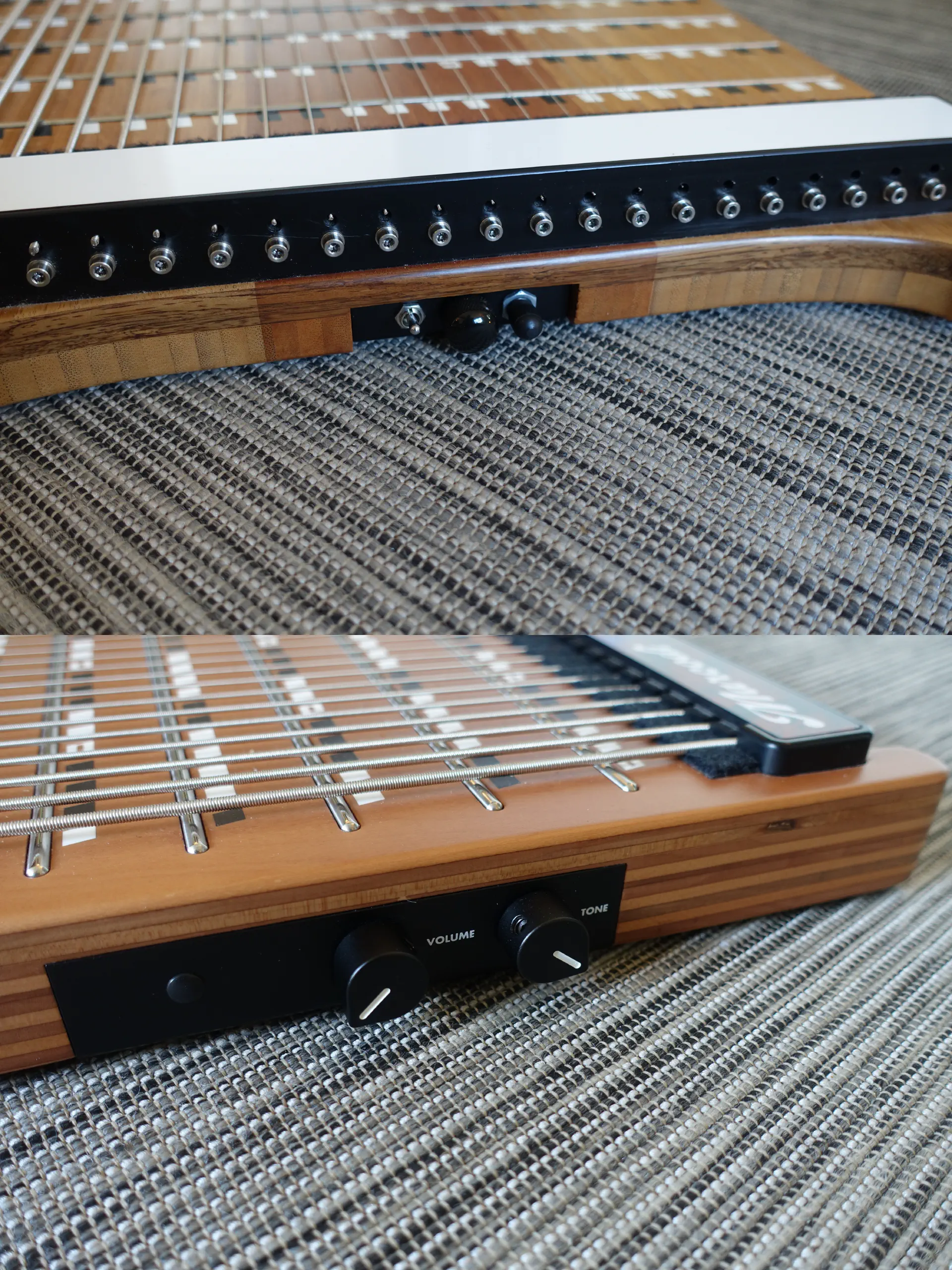
(Note that my K24 has a custom mono switch, so the top image is not a typical K24 representation)
Frets
The M5 benefits from the new “pepperoni” frets Marcodi designed specifically for their instruments. I’m not sure what part of it is to be attributed to the new frets, but the instrument does feel smoother to play than the K24. The feeling is as if the string tension was slightly lower and/or the string wider: the strings do get a little bit less “into” the fingers when playing.
Of course to be sure I’d have to try two instruments with exactly the same specs except for the frets (and that might very well be that two such instruments simply do not exists), but in the end, who cares? The M5 provides a very nice feeling under the fingers, and that’s what’s important!
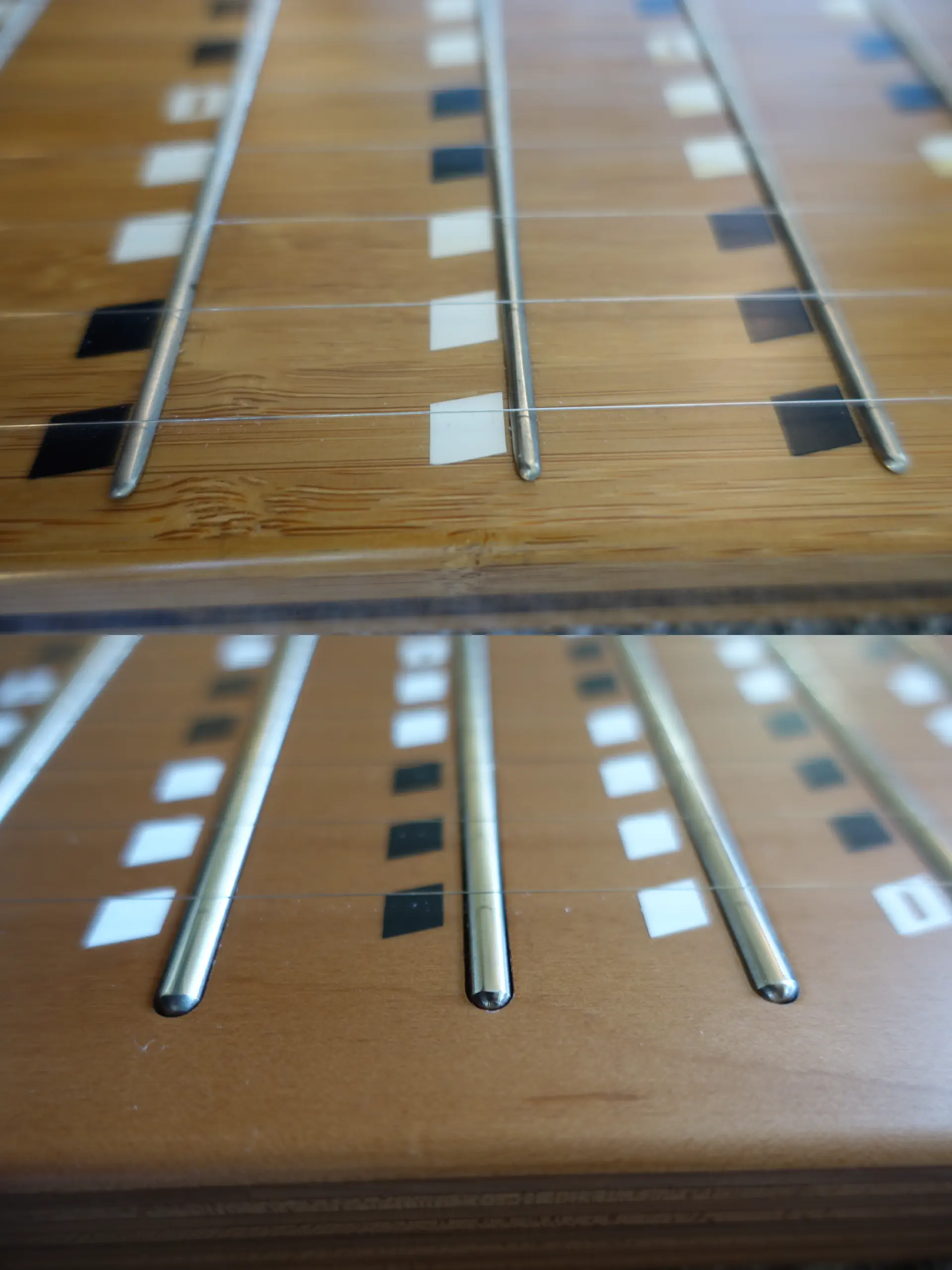
Saddles & pickups
The K24 is using standard guitar saddles that have been filed to accommodate the non-standard gauges. It works, but it means that the lower strings are closer to the pickups than the higher strings, because the saddle has been filed deeper. As the lower strings also naturally have a higher output volume, it necessitates a lot of volume compensation in the electronics to get a balanced volume throughout the instrument.
The M5 has the new, custom saddles that don’t require filing. Not only do they look nicer, but they need less volume compensation. According to Marcodi, that should mean less hiss, which I don’t find very perceivable, but I hear a huge difference regarding “mute pops”, which is great news. More on that later.
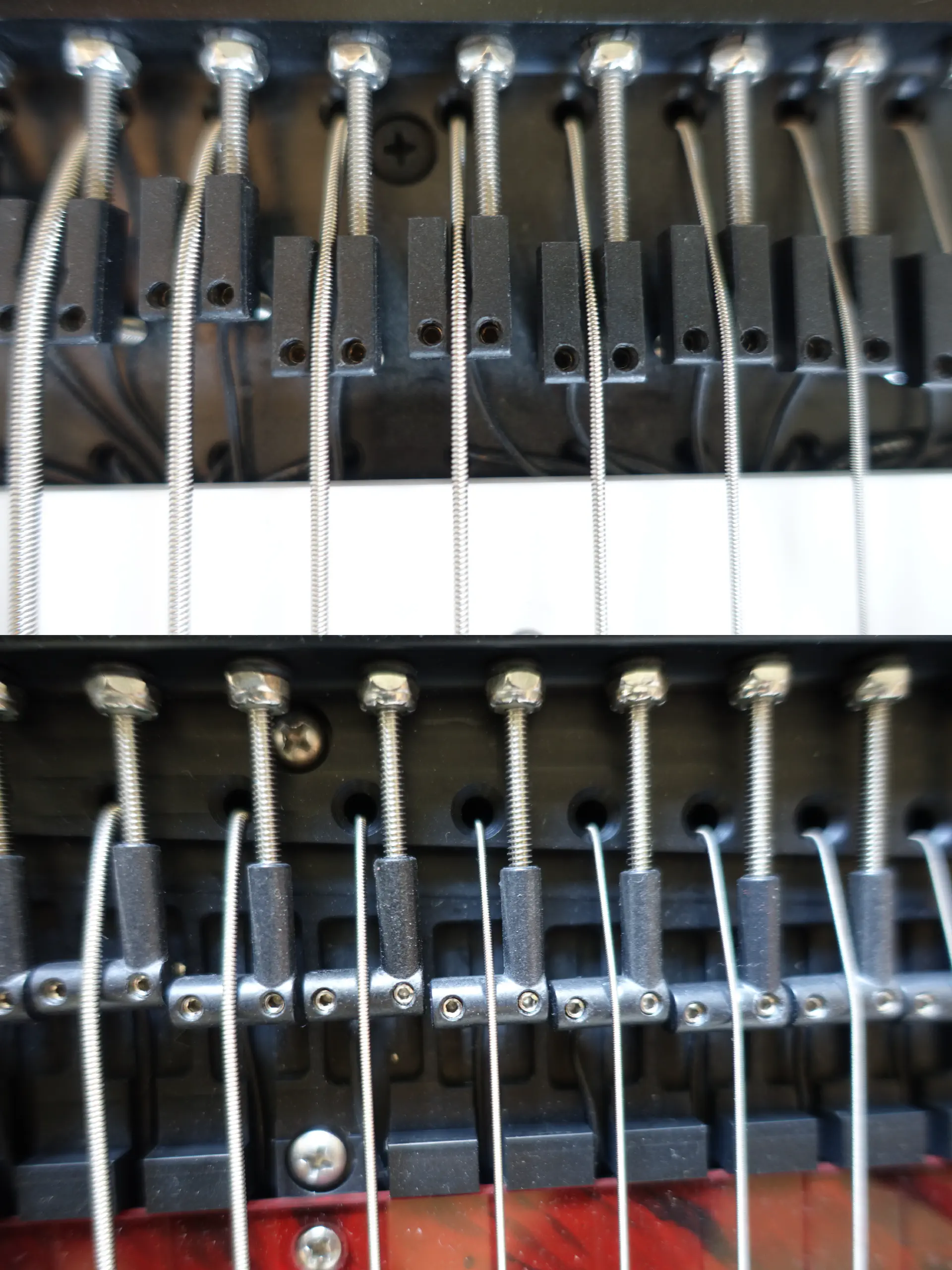
It might also be that the new saddles could simplify experimenting with different string gauges. I never felt the need, but I guess that someone wanting to put strings with other gauges on a K24 could have troubles with the specially filed saddles. If I understand well, all saddles on the M5 are identical, so experimenting with alternate gauges and/or tuning should be much easier. This is just a guess, though, that would have to be validated by Marcodi.
Cosmetics
The M5 also features a new Marcodi logo, and the so-called accent plates, which were plain white on my K24, are now “Glossy hand painted tortoise with deep embedded logos” (to quote Marcodi’s website).
To be completely honest, the way an instrument sounds is for me way more important than how it looks. I guess the new cosmetics give the instrument a more professional finish, and I’m sure this is important to many harpejji owners, but frankly I don’t really care.
Harpejji M5: Range and note placement
I left aside until now one of the most visible difference between the K24 and the M5 because, given its importance, I wanted to dedicate a full section to it.
Marcodi has decided to change the string number, scale length and overall range of the instrument. The K24 has 24 strings and 15 frets, with exactly 5 octaves ranging from A0 to A5. The M5 has fewer strings (22), more frets (19) and also covers 5 octaves, but a minor third higher (C1 to C6).
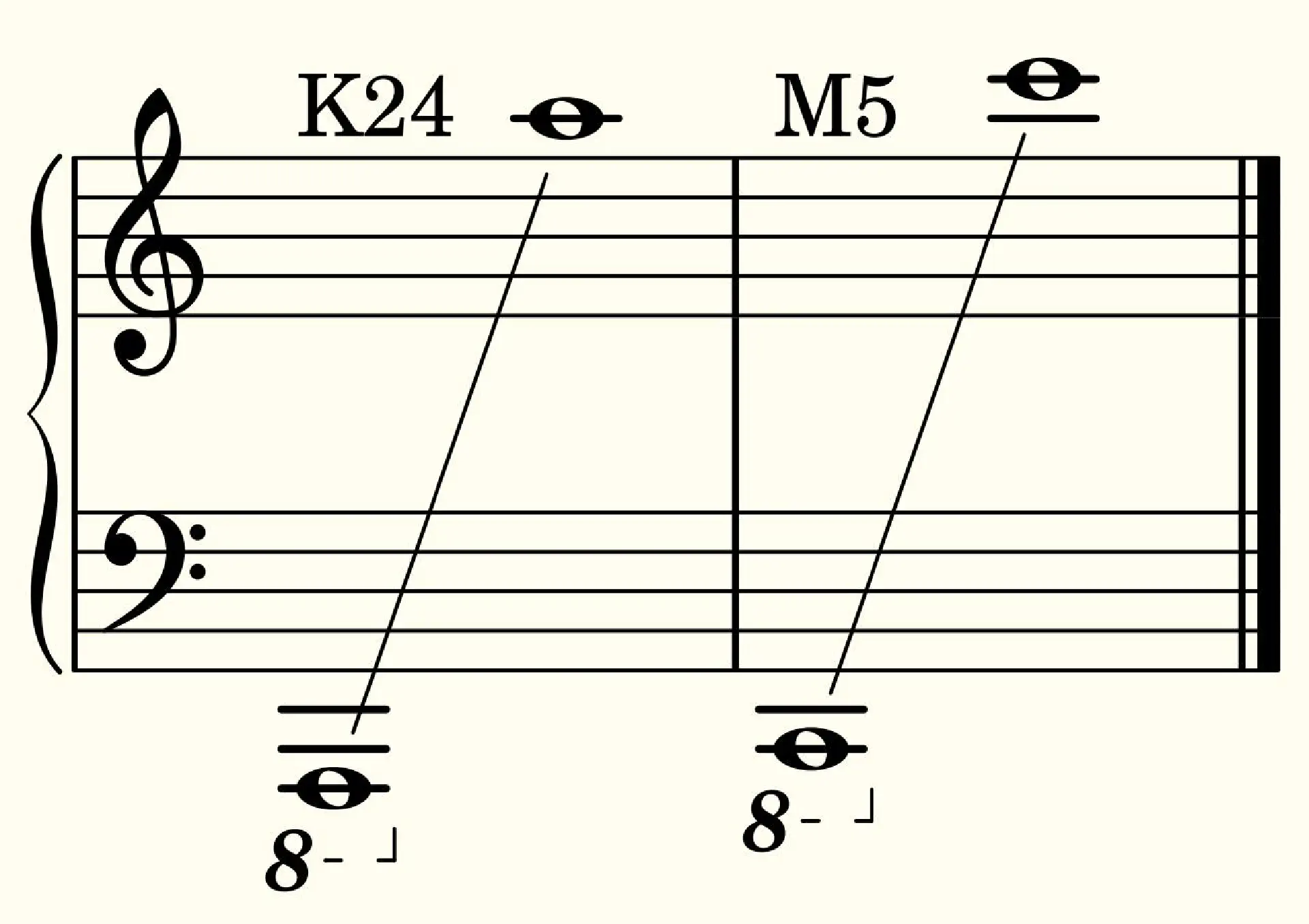
To me, the range shift is a blessing. I’m rarely using the very lowest notes of my K24, but I often find that a highest note at A5 is a little bit limiting, especially when trying to sight-read piano music. C6 is still not very high (remember I was trained as a classical flautist 😉), but it’s already much better.
The shorter scale length yields a narrower fret spacing. In the lower part of the strings, I feel the difference is barely perceivable. If anything, it makes things a tiny bit easier. I was afraid however that the very small spacing in the higher part of the strings, due both to the shorter scale length and the higher number of frets, would be difficult to master. But although it does take some time to get accustomed to it, the space between frets is still much larger than my fingers and there’s no real problem playing up there.
When improvising in the middle range of the instrument, I don’t really notice any difference in note placement between the K24 and the M5. When playing music I wrote for the K24 however, I sometimes run out of strings on the right side of the instrument. That means I’ve got either to modify my fingerings to play more “vertically” on the fretboard, or I’ve got to play on higher frets (hence more to the left to get the same notes). The second solution is sometimes slightly less ergonomic, because playing on higher frets means stretching the arms further away from the body and/or leaning forward a little bit more. It might be that the real solution there, if I want to keep the same ergonomics, is to transpose the music 1 or 2 tones lower (although it obviously has an impact on the music too!).
But all in all, I feel the changes in notes geometry completely make sense and make the instrument more suited to many musical situations.
(Temporary) Conclusion
In this post, I reviewed what I feel are the most important outer aspects of the new M5. I also compared them with the K24. But of course this is only the tip of the iceberg: the really important part is how it sounds, and how it helps you to make music. That will be the focus of a next post on this blog, so… stay tuned!
Do you find this post useful? Would you like to see more content about the harpejji on this blog in the future?
Writing about harpejji technique is time-consuming. If you can afford it, please consider donating to support this work. Even a small donation helps, so don't hesitate!
You can support me through Les Chemins de Traverse, the cultural organization I co-created and I've been working for over the past 25+ years. Please go to their support page (in french) or use this direct Paypal link. Thank you!